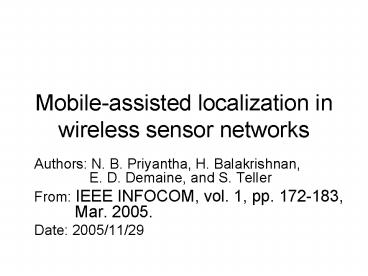Mobileassisted localization in wireless sensor networks PowerPoint PPT Presentation
1 / 27
Title: Mobileassisted localization in wireless sensor networks
1
Mobile-assisted localization in wireless sensor
networks
- Authors N. B. Priyantha, H. Balakrishnan,
E. D. Demaine, and S. Teller - From IEEE INFOCOM, vol. 1, pp. 172-183,
Mar. 2005. - Date 2005/11/29
2
Outline
- Introduction
- Related work
- The case for mobile-assisted localization
- Theoretical framework and movement strategies
- Anchor-free localization
- Performance evaluation
- Conclusion
3
1. Introduction
- Implement a localization algorithm in real-world
system - Prob. 1 physical obstacles
- Prob. 2 too few distance constraints to obtain a
consistent coordinate assignment - Mobility can help solve these problems
- Mobile-assisted localization
- A roving robot wanders through an area, collect
distance info. between the nodes and itself.
4
2. Related work
- User-friendly surveying tech. for location-aware
systems - Node localization using mobile robots in
delay-tolerant sensor networks - Networked robots flying robot navigation using a
sensor net - Localization of WSNs with a mobile beacon
- RADAR
5
3. The case for mobile-assisted localization
- A localization algorithm
- needs a sufficient number of pairwise node
distance to be able to compute node coordinates
correctly. - For indoor environment
- Obstructions
- Sparse node deployments
- Geometric dilution of precision (GDOP)
6
4. Theoretical framework and movement strategies
- Connections to rigidity
- Engineering rigidity
- MAL distance measurement
- Calculating distance between two nodes
- Calculating distances between three nodes
- Calculating distances between four (or more) nodes
7
- Global rigid in d dimensions
- The removal of any d vertices must leave the
graph connected (d1 connectivity) - The removal of any edge must leave the graph
generically locally rigid.
8
Engineering rigidity
TH1 a graph is globally rigid if it is formed by
starting from a clique of 4 non-coplanar nodes
and repeatedly adding a node connected to at
least 4 non-coplanar existing nodes.
P4
9
MAL distance measurement
Mobile node
Computing distance between two nodes by measuring
distances from 3 points.
10
- Proposition 2 the geometry of 5 coplanar points
where are
collinear, is determined by the distances
for i 0, 1 and j 0, 1, 2 - Proposition 3 the geometry of 3 non-collinear
points above the plane containing 6
coplanar points no 3 of
which are collinear, is determined by the
distances for i 0, 1, 2 and j 0, 1,
2, 3 ,4 ,5
11
- Proposition 4 the geometry of 11 non-collinear
points no 4 of which are coplanar,
is determined by the distances for i
1, 2, 3, 4 and j 1, 2, 3 ,4 ,5, 6, 7
12
- MAL movement strategy
- Initialize
- Find 4 stationary nodes that can all be seen from
a common mobile location - Move the mobile to at least 7 nearby localtions
and measure distances. - Compute the pairwise distances between the 4
stationary nodes - Localize the resulting tetrahedron
- Loop
- Pick a stationary node that has been localized
but not yet been examined by this loop (DFS) - Move the mobile around the visibility region of
that stationary node - For each such mobile position
- Compute the distances among those 2, 3, or 4
stationary nodes - If the not-yet-localized stationary node now has
4 known distances to localized stationary nodes,
localize it according to TH 1.
13
- TH 5 the mobile movement strategy described
above is guaranteed to find a globally rigid
graph on the stationary nodes of the type
described in TH1 provided that such a graph can
be constructed using 1 mobile - TH 6 the number of distance measurements made by
the mobile movement strategy described above is
linear in the number of stationary nodes. - TH 7 the total distance traveled by the
depth-first mobile movement strategy described
above is proportional to the product of the
number of stationary nodes and the perimeter of a
stationary nodes visibility region.
14
5. Anchor-free localization (AFL)
- AFL runs in 2 phases
- Computes an initial coordinate assignment for
nodes.Uses the shortest path hop count from
these elected nodes to compute the initial
coordinates of each node i. - Uses a non-linear optimization algorithm to
minimize the sum-squared energy
15
The shortest path hop count between 3 and i The
range of the nodes in the graph dij denote the
(true) Euclidean distance between i and j
The computed distance between i and j obtained
from the current coordinate assignment of the
node The measured distance between the node i and
j obtained by MAL
16
6. Performance evaluation
- End-to-end localization performance of MAL runing
in conjunction with AFL - Using 24-node real-world Cricket-based testbed.
17
(No Transcript)
18
lt5 cm
19
The node connectivity graph obtained by
MAL Mobile at 1592 pointsUsed 3 nodes at a time
approachDistance estimation algo. on 52
different triangles formed by different node
combinationsThe edge of these triangles
represented 59 unique edges connecting the nodes
20
0.9
0.5
1.5
( edge length error)
21
Graph obtained after running the AFL
initialization using RF connectivity information
22
Coordinates obtained after running the AFL
optimization
23
(No Transcript)
24
with r10
25
(No Transcript)
26
(No Transcript)
27
7. Conclusion
- MAL method which employs a mobile user to assist
in measuring distances between node pairs until
these distance constraints from a globally rigid
structure that guarantees a unique localization.

